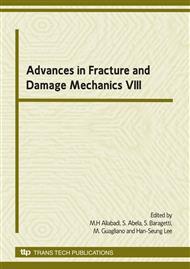p.41
p.45
p.49
p.53
p.57
p.61
p.65
p.69
p.73
Influence of Small Surface Defects on Fatigue Limit of Nitrided and Shot Peening Steel
Abstract:
Effects of surface defect size and the method used to obtain the defect itself on bending fatigue behaviour of nitrided and shot peened steel was studied. Two different series of 15 sandglass specimens with a microhole in the minimum section generated after nitriding and shot peening treatments were considered. In one series the microholes were obtained by controlled electro-erosion. In the other series microholes were obtained by indentation, much more invasive that electro-erosion, simulating a damage due to a mechanical impact or scratch on the surface material, common on real components during the life span. In both cases the microholes act as a pre-existent crack. The results show that defects obtained by indentation lead to a minor fatigue limit with respect of larger defects obtained by electro-erosion. This was interpreted as the modification of the residual stress field due to the mechanical indentation. On the basis of the results some consideration is formulated about generating micro-holes with one of the discussed ways.
Info:
Periodical:
Pages:
57-60
Citation:
Online since:
October 2009
Keywords:
Price:
Сopyright:
© 2010 Trans Tech Publications Ltd. All Rights Reserved
Share:
Citation:


